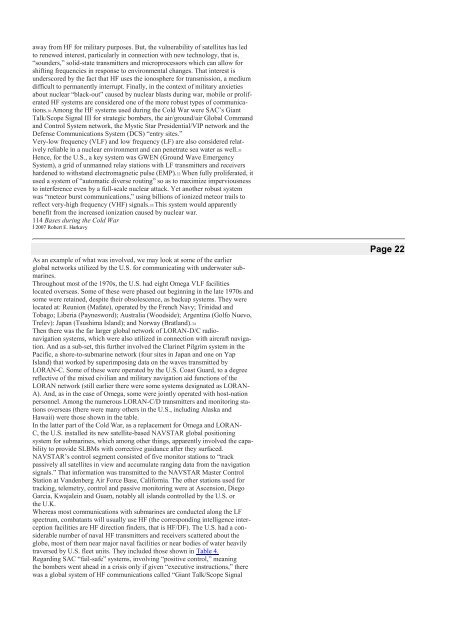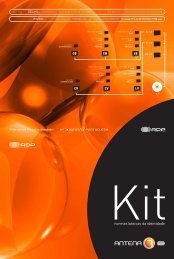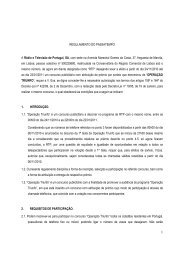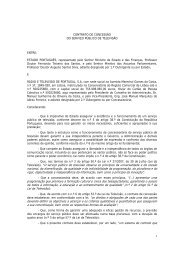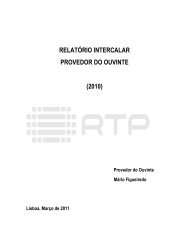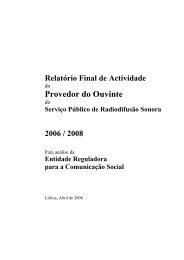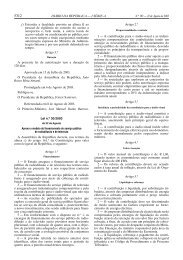6 Bases during the Cold War
6 Bases during the Cold War
6 Bases during the Cold War
Create successful ePaper yourself
Turn your PDF publications into a flip-book with our unique Google optimized e-Paper software.
away from HF for military purposes. But, <strong>the</strong> vulnerability of satellites has ledto renewed interest, particularly in connection with new technology, that is,“sounders,” solid-state transmitters and microprocessors which can allow forshifting frequencies in response to environmental changes. That interest isunderscored by <strong>the</strong> fact that HF uses <strong>the</strong> ionosphere for transmission, a mediumdifficult to permanently interrupt. Finally, in <strong>the</strong> context of military anxietiesabout nuclear “black-out” caused by nuclear blasts <strong>during</strong> war, mobile or proliferatedHF systems are considered one of <strong>the</strong> more robust types of communications.30Among <strong>the</strong> HF systems used <strong>during</strong> <strong>the</strong> <strong>Cold</strong> <strong>War</strong> were SAC’s GiantTalk/Scope Signal III for strategic bombers, <strong>the</strong> air/ground/air Global Commandand Control System network, <strong>the</strong> Mystic Star Presidential/VIP network and <strong>the</strong>Defense Communications System (DCS) “entry sites.”Very-low frequency (VLF) and low frequency (LF) are also considered relativelyreliable in a nuclear environment and can penetrate sea water as well.31Hence, for <strong>the</strong> U.S., a key system was GWEN (Ground Wave EmergencySystem), a grid of unmanned relay stations with LF transmitters and receivershardened to withstand electromagnetic pulse (EMP).32 When fully proliferated, itused a system of “automatic diverse routing” so as to maximize imperviousnessto interference even by a full-scale nuclear attack. Yet ano<strong>the</strong>r robust systemwas “meteor burst communications,” using billions of ionized meteor trails toreflect very-high frequency (VHF) signals.33 This system would apparentlybenefit from <strong>the</strong> increased ionization caused by nuclear war.114 <strong>Bases</strong> <strong>during</strong> <strong>the</strong> <strong>Cold</strong> <strong>War</strong>İ 2007 Robert E. HarkavyAs an example of what was involved, we may look at some of <strong>the</strong> earlierglobal networks utilized by <strong>the</strong> U.S. for communicating with underwater submarines.Throughout most of <strong>the</strong> 1970s, <strong>the</strong> U.S. had eight Omega VLF facilitieslocated overseas. Some of <strong>the</strong>se were phased out beginning in <strong>the</strong> late 1970s andsome were retained, despite <strong>the</strong>ir obsolescence, as backup systems. They werelocated at: Reunion (Mafate), operated by <strong>the</strong> French Navy; Trinidad andTobago; Liberia (Paynesword); Australia (Woodside); Argentina (Golfo Nuevo,Trelev): Japan (Tsushima Island); and Norway (Bratland).34Then <strong>the</strong>re was <strong>the</strong> far larger global network of LORAN-D/C radionavigationsystems, which were also utilized in connection with aircraft navigation.And as a sub-set, this fur<strong>the</strong>r involved <strong>the</strong> Clarinet Pilgrim system in <strong>the</strong>Pacific, a shore-to-submarine network (four sites in Japan and one on YapIsland) that worked by superimposing data on <strong>the</strong> waves transmitted byLORAN-C. Some of <strong>the</strong>se were operated by <strong>the</strong> U.S. Coast Guard, to a degreereflective of <strong>the</strong> mixed civilian and military navigation aid functions of <strong>the</strong>LORAN network (still earlier <strong>the</strong>re were some systems designated as LORAN-A). And, as in <strong>the</strong> case of Omega, some were jointly operated with host-nationpersonnel. Among <strong>the</strong> numerous LORAN-C/D transmitters and monitoring stationsoverseas (<strong>the</strong>re were many o<strong>the</strong>rs in <strong>the</strong> U.S., including Alaska andHawaii) were those shown in <strong>the</strong> table.In <strong>the</strong> latter part of <strong>the</strong> <strong>Cold</strong> <strong>War</strong>, as a replacement for Omega and LORAN-C, <strong>the</strong> U.S. installed its new satellite-based NAVSTAR global positioningsystem for submarines, which among o<strong>the</strong>r things, apparently involved <strong>the</strong> capabilityto provide SLBMs with corrective guidance after <strong>the</strong>y surfaced.NAVSTAR’s control segment consisted of five monitor stations to “trackpassively all satellites in view and accumulate ranging data from <strong>the</strong> navigationsignals.” That information was transmitted to <strong>the</strong> NAVSTAR Master ControlStation at Vandenberg Air Force Base, California. The o<strong>the</strong>r stations used fortracking, telemetry, control and passive monitoring were at Ascension, DiegoGarcia, Kwajalein and Guam, notably all islands controlled by <strong>the</strong> U.S. or<strong>the</strong> U.K.Whereas most communications with submarines are conducted along <strong>the</strong> LFspectrum, combatants will usually use HF (<strong>the</strong> corresponding intelligence interceptionfacilities are HF direction finders, that is HF/DF). The U.S. had a considerablenumber of naval HF transmitters and receivers scattered about <strong>the</strong>globe, most of <strong>the</strong>m near major naval facilities or near bodies of water heavilytraversed by U.S. fleet units. They included those shown in Table 4.Regarding SAC “fail-safe” systems, involving “positive control,” meaning<strong>the</strong> bombers went ahead in a crisis only if given “executive instructions,” <strong>the</strong>rewas a global system of HF communications called “Giant Talk/Scope SignalPage 22


